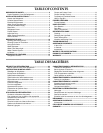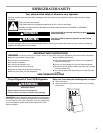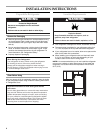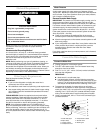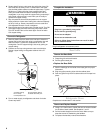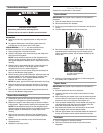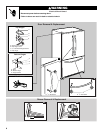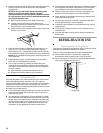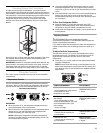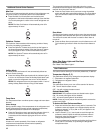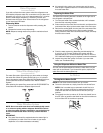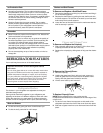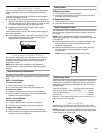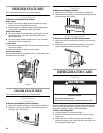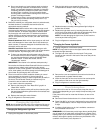
10
2. Install the interior water filter. The interior water filter mounting
bracket is located on the left side wall of the refrigerator
compartment.
NOTE: Do not use with water that is microbiologically
unsafe or of unknown quality without adequate
disinfection before or after the system. Systems certified
for cyst reduction may be used on disinfected waters that
may contain filterable cysts.
■ Remove blue bypass cap and retain for later use.
■ Carefully remove the interior water filter from its
packaging. Remove the sealing label from the end of the
filter and insert it into the filter head.
■ Gently rotate the filter clockwise until it stops. Then snap
the filter cover closed.
3. Flush the water system by dispensing and discarding 2 to
3 gal. (8 to 12 L) of water. Flushing the system will take
approximately 6 to 7 minutes and will help clear air from the
line. Additional flushing may be required in some households.
NOTE: As air is cleared from the system, water may spurt out
of the dispenser.
4. Inspect the filter system for water leaks. If you see water
leaks, see the “Troubleshooting” section.
5. Turn on the ice maker by opening the freezer door and
lowering the wire shutoff arm as shown.
Please refer to the
“Ice Maker” section for further instructions on the operation
of your ice maker.
■ Allow 24 hours to produce the first batch of ice.
■ Discard the first three batches of ice produced.
Normal Sounds
Your new refrigerator may make sounds that your old one didn’t
make. Because the sounds are new to you, you might be
concerned about them. Most of the new sounds are normal. Hard
surfaces, such as the floor, walls, and cabinets, can make the
sounds seem louder. The following describes the kinds of sounds
and what may be making them.
■ If your refrigerator is equipped with an ice maker, you will hear
a buzzing sound when the water valve opens to fill the ice
maker for each cycle.
■ Your refrigerator is designed to run more efficiently, to keep
your food items at the desired temperatures and to minimize
energy usage. The high efficiency compressor and fans may
cause your refrigerator to run longer than your old one. You
may also hear a pulsating or high-pitched sound from the
compressor or fans adjusting to optimize performance.
■ You may hear the evaporator fan motor circulating air through
the refrigerator and freezer compartments. The fan speed
may increase as you open the doors or add warm food.
■ Rattling noises may come from the flow of refrigerant, the
water line, or items stored on top of the refrigerator.
■ Water dripping on the defrost heater during a defrost cycle
may cause a sizzling sound.
■ As each cycle ends, you may hear a gurgling sound due to
the refrigerant flowing in your refrigerator.
■ Contraction and expansion of the inside walls may cause a
popping noise.
■ You may hear air being forced over the condenser by the
condenser fan.
■ You may hear water running into the drain pan during the
defrost cycle.
REFRIGERATOR USE
Opening and Closing Doors
There are two refrigerator compartment doors. The doors can be
opened and closed either separately or together.
There is a vertically-hinged seal on the left refrigerator door.
■ When the left side door is opened, the hinged seal
automatically folds inward so that it is out of the way.
■ When both doors are closed, the hinged seal automatically
forms a seal between the two doors.
A.Hinged seal
A



